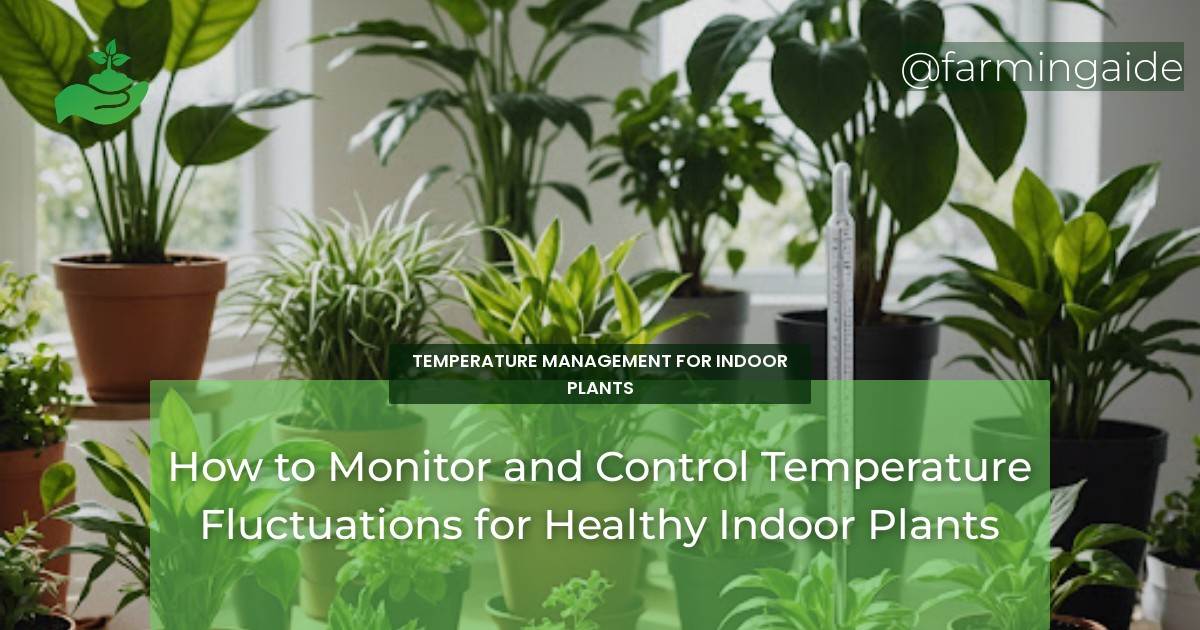As an indoor plant enthusiast, you understand the importance of providing your plants with the right environment to thrive. Temperature is one of the most critical factors affecting plant health, and even slight fluctuations can cause stress and damage. In this article, we’ll delve into the world of temperature management for indoor plants, exploring the ideal temperature ranges, tools for monitoring, and strategies for controlling temperature fluctuations. By the end of this comprehensive guide, you’ll be equipped with the knowledge to create the perfect temperature conditions for your plants to flourish.
Key Takeaways
- Understanding the ideal temperature range for your indoor plants is crucial for their health and well-being.
- Temperature fluctuations can cause stress, disease, and pest issues in plants.
- Monitoring temperature with digital thermometers and hygrometers can help identify potential issues.
- Strategies for controlling temperature fluctuations include insulation, heating and cooling systems, and ventilation.
- Seasonal adjustments and troubleshooting common temperature-related issues are essential for maintaining healthy plants.
Understanding the Ideal Temperature for Indoor Plants
Each indoor plant species has its unique temperature requirements, which can vary significantly. Generally, most plants prefer daytime temperatures between 65°F (18°C) and 75°F (24°C), while nighttime temperatures can be 5-10°F (3-6°C) lower. However, some plants like succulents and cacti can tolerate higher temperatures, while tropical plants prefer warmer conditions.
It’s essential to research the specific temperature needs of your plants to ensure optimal growth and health. A temperature range that’s too wide or extreme can cause stress, leading to disease and pest issues.
Common Temperature Ranges for Popular Indoor Plants
| Plant Type | Ideal Temperature Range (°F/°C) |
|---|---|
| Spider Plants | 65-75°F (18-24°C) |
| Succulents and Cacti | 65-85°F (18-29°C) |
| Ferns | 60-70°F (16-21°C) |
| Bromeliads | 65-75°F (18-24°C) |
Effects of Temperature Fluctuations on Plant Health
Temperature fluctuations can have devastating effects on plant health, including:
- Stress and shock, leading to disease and pest issues.
- Disruption of photosynthesis and growth.
- Root damage and nutrient deficiencies.
- Increased water loss and drought stress.
Tools for Monitoring Indoor Plant Temperature
To maintain optimal temperature conditions, you’ll need the right tools to monitor and control temperature fluctuations. Two essential tools are:
ALSO READ
Digital Thermometers and Hygrometers
Digital thermometers provide accurate temperature readings, while hygrometers measure humidity levels. These tools help you identify temperature fluctuations and adjust your environment accordingly.
When choosing a digital thermometer, consider the following factors:
- Accuracy and precision.
- Response time and speed.
- Range and resolution.
- Battery life and durability.
Smart Home Devices for Temperature Control
Smart home devices can help you monitor and control temperature remotely, ensuring your plants receive the ideal conditions. These devices often integrate with thermostats, heaters, and cooling systems, providing a comprehensive temperature management system.
When selecting a smart home device, consider the following factors:
- Compatibility with your thermostat and heating/cooling systems.
- Remote monitoring and control capabilities.
- Alert systems for temperature fluctuations.
- Energy efficiency and cost-effectiveness.
Strategies for Controlling Temperature Fluctuations
To maintain optimal temperature conditions, you can employ various strategies, including:
ALSO READ
Insulation and Placement Techniques
Proper insulation and placement can help regulate temperature fluctuations. Consider:
- Using thermal curtains or window treatments.
- Placing plants near heating or cooling vents.
- Grouping plants to share heat and maintain humidity.
Using Heating and Cooling Systems
Heating and cooling systems can help maintain optimal temperatures. Consider:
- Space heaters or radiant heaters for cold spots.
- Cooling systems or fans for hot spots.
- Programmable thermostats for temperature scheduling.
Ventilation and Air Circulation
Proper ventilation and air circulation can help regulate temperature fluctuations. Consider:
- Opening windows for cross-ventilation.
- Using fans to circulate air.
- Installing vents or whole-house fans.
Seasonal Adjustments for Temperature Control
As the seasons change, your plants’ temperature requirements may shift. Be prepared to make adjustments to ensure optimal conditions.
Winter Care for Indoor Plants
In winter, plants often require cooler temperatures and reduced watering. Consider:
- Reducing temperature by 5-10°F (3-6°C).
- Decreasing water frequency and amount.
- Providing humidity with pebble trays or humidifiers.
Summer Heat Management
In summer, plants often require warmer temperatures and increased watering. Consider:
- Increasing temperature by 5-10°F (3-6°C).
- Increasing water frequency and amount.
- Providing shade or using sunshades.
Troubleshooting Common Temperature-Related Issues
If you notice temperature-related issues, it’s essential to identify the problem and take corrective action.
Signs of Temperature Stress in Plants
Watch for signs of temperature stress, including:
- Yellowing or droopy leaves.
- Slow growth or stunted development.
- Increased susceptibility to disease and pests.
Remedies for Overheating and Freezing
If you notice overheating or freezing issues, take immediate action:
- Move plants to a cooler or warmer location.
- Adjust heating or cooling systems.
- Provide shade or use thermal blankets.
Conclusion and Final Tips for Temperature Management
By understanding the ideal temperature range for your indoor plants and employing strategies to monitor and control temperature fluctuations, you’ll create an optimal environment for your plants to thrive. Remember to:
- Monitor temperature regularly.
- Adjust temperature according to seasonal changes.
- Troubleshoot temperature-related issues promptly.
With these tips and strategies, you’ll be well on your way to becoming a temperature management expert, ensuring your indoor plants receive the perfect conditions to flourish.


